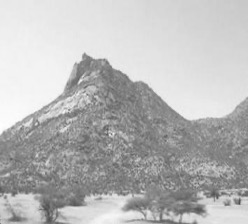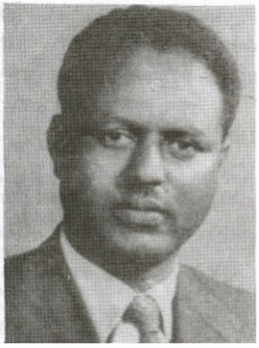
60 years ago, a small group of ill-equipped but determined #Eritrea|ns, led by the legendary Hamid Idris Awate, initiated an epic historical journey with the aim to liberate, by an armed struggle, Eritrea from #Ethiopia|n occupation & to restore to the Eritrean people the right 



to determine the nature of the political community they want to live in and over the running of which they would have a meaningful say. The struggle was b/n two unequals: between the aid-bloated #Ethiopia|n Leviathan, and the ill-armed, largely marginalised subaltern #Eritrea|n
Liberation Front. The principal political objective that animated the #Eritrea|n armed struggle was the creation of a democratic and egalitarian society. Beginning from 1953, the #Ethiopia|n government systematically eroded the principles and institutions of the Federation with
#Eritrea: making unduly interference in the work of the Eritrean government; clamping down on independent media, like Dehai, and unlawfully jailing journalists; undermining the independence and integrity of the Eritrean judiciary; intimidating and exiling prominent Eritrean
politicians such as Weldeab Weldemariam, Ibrahim Sultan, and Omer Akito; replacing Tigrinya and Arabic by Amharic as a language of state & education; lowering the Eritrean flag and replacing it with the #Ethiopia|n flag; and finally abolishing the #Eritrea|n government 





and #Eritrea’s status as autonomous state without the approval of the United Nations General Assembly- the only body which the UN Resolution 390 A (V) entrusted with the ultimate power to decide the fate of the federation.
#Eritrea|ns responded to the abrogation of their rights with non-violent demonstrations. Students and workers in various urban centers organised staged peaceful protests However, they were met with brutal #Ethiopia| force. With the process of dismantlement of the federation
and the growing hostilities of #Ethiopia|n government against many nationalist leaders, many #Eritrea|ns went to Egypt and other Middle eastern countries as political exiles. Prominent among them were Weldab Weldemariam, Ibrahim Sultan and Idris Muhammad Adem.
In the 1950s and 1960s, during the rule of Jamal Abdel Nasser , Egypt instituted a generous educational policy of admission to students from Africa and the Middle East to its secondary and higher education institutions. This encouraged many #Eritrea|ns to pursue their higher
education in Egypt which was not available in Eritrea. With the imposition of Amharic as a medium of instruction in the late 1950s, many students went to Egypt to continue their secondary education. By the end of 1950s, the was a large community of #Eritrea|ns in Cairo.
In July 1960 a group of #Eritrea|n nationalists in Cairo announced the formation of Eritrean Liberation Front (ELF). The front stressed the necessity of armed struggle. The highest leadership of the ELF was called the Provisional Executive Committee. Idris Mohammad Adam,
the former chairman of the Eritrean assembly, was the leader of the committee and Idris Osman Galawdewos, an #Eritrea|n law student in Cairo, was a member of the Provisional Executive Committee and deputy of Idris Mohammad Adam. 





On September 1, 1961, Hamid Idris Awate commenced the #Eritrea|n armed Struggle against the occupation of the #Ethiopia|n imperial state by engaging an Ethiopia police force at Mt. Adal. At the beginning, Hamid Idris Awate had 7 comrades, armed with six old rifles.
Eventually, nine non-commissioned #Eritrea|n officers, who were serving in the Sudanese army, resigned from the Sudanese army and joined Awate. Awate and his comrades carried out multiple successful military operations, targeting high profile #Ethiopia|n officials 

and their cronies in Eritrea and military and police camps. Awate did not stay long. He died of an illness in June of 1962 but his death was kept secret to maintain morale of the fighters and the #Eritrea|n people. In 1962, the Provisional Executive Committee was dissolved after
Osman Saleh Sabbe joined the #Eritrea|n Liberation Front, as a member of the leadership. In its place, a triumvirate leadership named Revolutionary Command (RC) was created, which later became the Supreme Council. While Idris Mohammed Adem remained titular head and spokesman of
the ELF, Gelawdewos took charge of military affairs and Sabbe was in charge of foreign relations. #Ethiopia responded to the #Eritrea|n armed struggle with brutal scorched earth counterinsurgency measures. It incarcerated thousands of #Eritrea|ns, accusing them of collaboration.
By 1963, #Ethiopia detained over 3000 #Eritrea|ns. It established a special counterinsurgency commando units, exclusively composed of Christian Eritreans and trained by Israeli military advisors. It unleashed ts military might on unarmed civilians in the Eritrean lowlands.
It burned villages and killed and displaced thousands. By 1967, close to hundred thousand #Eritrea|ns left ´their homes for refugee camps in #Sudan. Despite, or because of these brutal measures, #Eritrea|ns continued their epic fight for freedom, self-determination, & democracy. 

#Eritrea|ns were short of means. They had few friends. They were marginalised. They had bitter differences. However, they had a good cause, relentless determination and will-power, hope, grit, healthy patriotism, and progressive political agenda.
They eventually kicked out the emaciated #Ethiopia|n Leviathan from their land and won. That is the Awate spirit! May you all be blessed with that spirit!
Please forgive us for some of the typos. We at the NTT also make some typographical errors.😉
P.S. We want to add a little context to our reference to the special commando units, or commandis as they are commonly locally known, that Haile Selasie employed in the brutal counterinsurgency measures he unleashed on the people #Eritrea.
Haile Selasie's strategy was a classic case of divide et impera. Since, the bulk of the pioneering ELF fighters hailed from the #Eritrea|n lowlands, Haile Selasie tried to sow a permanent enmity & division between Christian highlanders and Muslim Lowlanders by constituting the
special counterinsurgency commando units entirely from Christian Eritrean recruits. However, as Saleh Sabbe noted in his excellent booklet on Eritrean history, #Eritrea|ns eventually saw through the evil plan. As Sabbe aptly put it:
"if there was any lesson to be learnt by the Eritrean people from bitter federation experience, then it was this immortal lesson: Its salvation lies only in its national unity, bypassing secondary contradictions."
• • •
Missing some Tweet in this thread? You can try to
force a refresh





